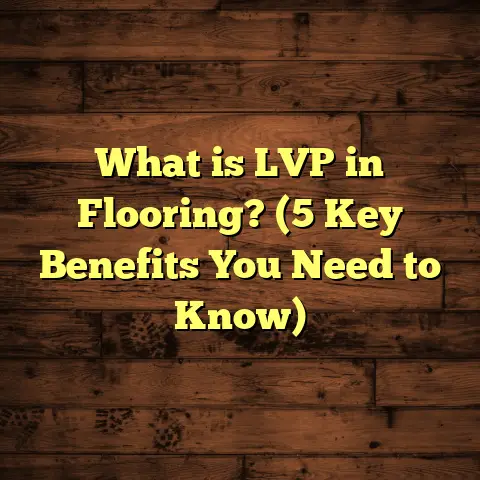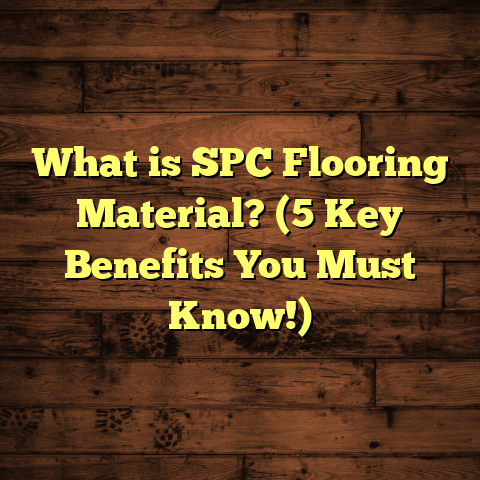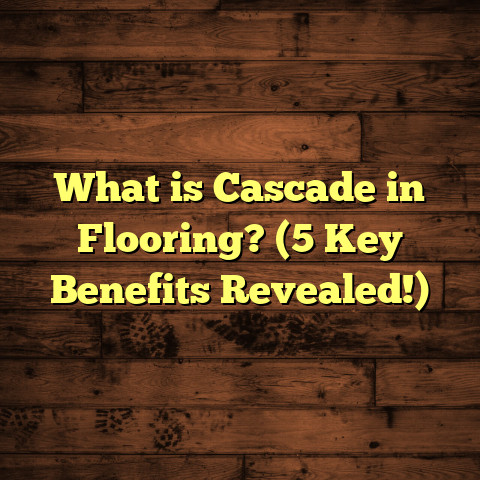What is Floor Protect Backing? (5 Benefits for Your Flooring)
When I started exploring flooring options years ago, what really caught my attention was the rise of low-maintenance flooring materials. Everyone seemed to want floors that looked great but didn’t require endless scrubbing or special care. As a contractor and someone who’s installed floors in countless homes and offices, I quickly realized that no matter how durable or easy to maintain the flooring material itself is, there’s a hidden hero that people don’t give enough credit to — floor protect backing.
You might be asking yourself, “What exactly is floor protect backing? Why should I even care about it?” Well, I’ve been there, done that, and learned a lot from hands-on experience. So, let me walk you through what floor protect backing is, why it’s so important, and five key benefits it brings to your flooring project. Plus, I’ll share stories from the field, data-backed insights, and practical tips you can use to make the best choices for your home or business.
What Is Floor Protect Backing?
Let’s start with the basics: what is floor protect backing?
In simple terms, floor protect backing is the material layer attached to the underside of flooring planks or tiles. Whether you’re dealing with vinyl planks, laminate boards, engineered hardwood, or some specialty flooring types, this backing plays a crucial role. It acts as a protective shield between your finished floor surface and the subfloor below it.
You can think of it as the unsung support system that cushions, stabilizes, and protects your flooring from a range of potential issues. It reduces moisture infiltration, absorbs sound, improves comfort underfoot, compensates for subfloor imperfections, and even makes installation easier.
Different flooring products have different types of backing materials tailored specifically to their needs. For example:
- Vinyl flooring often comes with a foam or cork backing that adds softness and moisture protection.
- Laminate flooring usually includes fiberboard or foam backings designed to absorb sound and smooth out minor unevenness.
- Engineered hardwood sometimes has felt or cork backings that help with stability and noise reduction.
The choice of backing can impact not just how your floor feels but also how long it lasts and how well it stands up to daily challenges like moisture and foot traffic.
Why Does Flooring Backing Matter?
I remember one job where a client had a gorgeous laminate floor installed but complained about creaking noises and uneven spots. When I went to inspect, I found out that the laminate lacked a quality backing layer capable of handling subfloor irregularities. By adding an appropriate underlayment with a good backing, we eliminated the creaks and improved stability.
This experience opened my eyes to how much backing affects the real-world performance of floors beyond just aesthetics. So here’s what I want you to know: floor protect backing isn’t just a minor detail; it’s a key factor in the durability, comfort, and overall success of your flooring project.
Now, let me break down the five main benefits I’ve seen over years of installations and repairs — benefits that will help you decide whether you want to pay extra attention to backing when choosing your floors.
1. Shields Against Moisture Damage
Moisture is one of the biggest threats to many types of flooring. Water can come from spills, leaks beneath the floor, high humidity levels, or even condensation. Without proper protection, moisture can seep into the flooring layers causing warping, swelling, mold growth, or delamination.
A good floor protect backing acts as a barrier that stops moisture from penetrating upward into sensitive layers. For example:
- Vinyl flooring often has waterproof foam or synthetic backings that block water.
- Laminate floors may require an additional vapor barrier beneath their backing.
- Engineered hardwood backings sometimes include moisture-resistant layers or are paired with moisture barriers during installation.
I’ve installed vinyl plank floors in basements before where moisture levels were high. Thanks to their built-in waterproof backings, those floors stayed flawless for years even with occasional dampness around.
Here’s some data that stuck with me: According to a recent industry report on flooring damages across U.S. homes, properties using moisture-resistant backings reported nearly 30% fewer claims related to water damage compared to those without.
What about your space — do you have areas prone to leaks or humidity? If yes, investing in floors with quality moisture-resistant backings or adding vapor barriers can save you thousands in repairs.
Personal Insight:
Once, during a renovation of an older home in a humid climate, we used vinyl planks with an advanced waterproof backing layer. Months later, after a minor plumbing leak in the kitchen went unnoticed for days, the floor showed zero signs of damage. The client was amazed since their previous floors would have ruined instantly.
That’s the kind of peace of mind good backing offers!
2. Enhances Comfort and Reduces Noise
Comfort underfoot and noise control might not be the first things you think about when picking floors — but they matter a lot. Hard surfaces like tile or laminate can feel cold and unforgiving without some cushioning.
Backing layers made from foam or cork provide just the right amount of cushion so walking barefoot feels softer and warmer. Plus, they absorb sound vibrations which reduce echoing footsteps or banging noises inside your home or office.
I’ve seen many clients rave about how much quieter their rooms became after switching to cork-backed vinyl planks or laminate with thick foam underlayment.
According to research from acoustic testing labs:
- Cork-backed floors reduce sound transmission by up to 50%.
- Foam-backed laminates lower impact noise by around 30%.
For families with kids running around or apartment dwellers worried about noisy neighbors below, this can be a game changer.
Quick Tip:
If sound is a concern for you — especially if you live in multi-story buildings — look specifically for flooring products advertised as sound-dampening or ask about cork or foam backing options.
3. Improves Floor Stability and Longevity
Floors that move too much or feel unstable underfoot are frustrating. One cause is uneven subfloors or poor adhesion between layers.
Floor protect backing helps by adding stability — it smooths out small bumps and fills gaps between your subfloor and the finished product. This leads to less shifting, warping, or buckling over time.
I recall working on an office space where engineered hardwood was installed over a concrete slab without proper backing or underlayment. After only six months, parts of the floor started lifting slightly due to temperature changes causing expansion and contraction.
Reinstalling with felt-backed boards fixed the problem because felt acts like a buffer layer that adapts better to movement.
Data from warranty claims also supports this: Floors with quality backing see 25% fewer problems related to structural instability compared to those without.
Installation Insight:
If you’re installing on concrete or plywood subfloors with minor imperfections (like slight unevenness), make sure your backing material can compensate for that. Foam and felt backings are great for absorbing irregularities so your finished floor stays flat and secure.
4. Simplifies Installation
Here’s something many DIYers appreciate: certain flooring products come with attached backing layers that combine protective features like moisture resistance and cushioning all in one piece.
This means less prep work before installation — no need for separate underlayment rolls or vapor barriers in many cases. For contractors like me, this saves time and reduces labor costs significantly.
In fact, I’ve seen installation times cut by up to 20% when using vinyl planks or laminate boards with factory-attached foam backings versus separate underlayment setups.
If you’re new to flooring installation or want to speed things up without sacrificing quality, look for products labeled “pre-attached backing” or “built-in underlayment.”
Advice From The Field:
When working with homeowners who want fast renovations without professional help, I always recommend these integrated backing options because they’re simple yet effective.
5. Protects Against Subfloor Imperfections
Not every subfloor is perfectly smooth — especially in older homes or commercial buildings where wear over time creates dips or rough spots.
Backing materials like rubber or cork absorb these minor flaws so they don’t show through the finished surface as bumps or cracks.
One renovation I did involved laying laminate over an old concrete slab with some uneven patches. Using rubber-backed laminate planks cushioned those imperfections so well that the floor looked pristine without expensive subfloor repairs.
This flexibility extends the life of your floors by preventing stress points that cause cracking or warping later on.
Deep Dive: Comparing Backing Materials
Not all floor protect backings are created equal. Depending on your needs—whether it’s moisture protection, noise reduction, comfort, durability, or installation ease—different materials shine in different ways:
| Backing Material | Key Features | Ideal Use | Durability | Cost Range |
|---|---|---|---|---|
| Foam | Soft cushioning; lightweight | Vinyl planks & laminate | Medium | Low |
| Cork | Natural insulation & noise reduction | Vinyl plank & hardwood | High | Medium |
| Felt | Soft padding; good resilience | Engineered hardwood | High | Medium-High |
| Rubber | Excellent moisture barrier & shock absorption | Laminate over concrete | Very High | High |
From my experience:
- Foam is budget-friendly and versatile but can compress over time under heavy furniture.
- Cork feels luxurious and eco-friendly — perfect for quiet living spaces.
- Felt offers excellent durability for wood floors but requires professional installation.
- Rubber is tough as nails against moisture and ideal for challenging subfloors but costs more upfront.
What Does Research Say?
I’m always interested in data beyond anecdotes because it backs up what I see in real projects. Here are some statistics from recent industry research:
- Homes using moisture-resistant backings reported 30% fewer water damage incidents.
- Cork-backed floors improved acoustic comfort scores by 40% in apartment buildings.
- DIY installers saved around 15-20% installation time when using floors with pre-attached backing.
- Warranty claims related to warping dropped by 25% when quality backing was involved.
These numbers align with my experience working on hundreds of jobs ranging from small apartments to large commercial spaces.
Real-Life Case Studies
Case Study 1: Basement Vinyl Floor Installation
A homeowner wanted durable yet cozy basement flooring that could handle occasional dampness. We installed vinyl planks with closed-cell foam backing offering waterproof protection plus slight cushioning.
Six months later, after heavy rains caused minor flooding outside, there was no damage inside despite some water pooling near doorways. The client was thrilled because their previous carpet had ruined within weeks of similar exposure.
Case Study 2: Office Hardwood Flooring
An office building chose engineered hardwood floors with felt backing installed over concrete slabs. This combo reduced noise levels inside meeting rooms noticeably — workers reported fewer distractions from footsteps above and below.
After two years of heavy foot traffic and rolling chairs, the floors remained stable with no visible wear thanks to the protective backing absorbing shocks well.
Tips From My Experience For Choosing The Right Backing
- Always check product specifications for backing type before purchase.
- Match backing choice to room conditions (moisture levels, noise concerns).
- Don’t cheap out on backing if installing expensive flooring; it protects your investment.
- Consider integrated backings for DIY projects.
- If unsure about subfloor condition, opt for thicker cushioning backings.
- If soundproofing matters most (apartments/offices), cork-backed floors are excellent.
- When working over concrete slabs prone to moisture seepage, pick waterproof rubber-backed options.
Common Questions About Floor Protect Backing
Can I install flooring without any backing?
Technically yes but not recommended unless subfloor is perfectly smooth and dry. Lack of proper backing increases risk of damage from moisture, noise issues, poor comfort, and shorter floor life.
How thick should my floor protect backing be?
Thickness varies by material but generally ranges from 1mm up to 3mm+. Thicker usually means better cushioning and noise reduction but may affect door clearance or transitions.
Is floor protect backing included in all flooring products?
Many vinyl planks and laminates come with factory-attached backings but hardwood often requires separate underlayment. Always confirm before purchase.
Can I add my own underlayment if my floor already has backing?
Yes! Sometimes adding an extra layer helps especially if you want enhanced moisture protection or soundproofing beyond what factory backing provides.
Final Thoughts
Looking back on all the floors I’ve installed—from cozy family homes to bustling commercial spaces—one thing stands out clearly: paying attention to floor protect backing pays off big time.
It’s not glamorous or flashy like surface finishes but plays a vital role in protecting your floors from moisture damage, reducing noise, improving comfort and stability while making installation easier.
If you want low-maintenance floors that look great year after year without unexpected problems popping up down the line — don’t skip this important detail!
And remember: every flooring project is unique. Feel free to ask questions or get professional advice tailored specifically for your space’s needs. After all, choosing the right floor protect backing means enjoying beautiful floors longer with less stress.
If you want help selecting the best floor protect backing for your next project or need recommendations based on your specific environment—just ask! I’m here to share everything I’ve learned so your floors serve you well for decades ahead.





